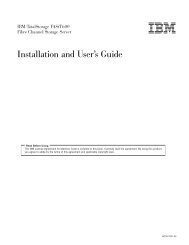Addressing OLTP Solutions with CICS: The Transaction Server ... - Ibm
Addressing OLTP Solutions with CICS: The Transaction Server ... - Ibm
Addressing OLTP Solutions with CICS: The Transaction Server ... - Ibm
You also want an ePaper? Increase the reach of your titles
YUMPU automatically turns print PDFs into web optimized ePapers that Google loves.
information being communicated and resources used for communication are<br />
unprotected from mischief or malice.<br />
In general, <strong>OLTP</strong> systems are built on private networks where you can more<br />
easily protect the privacy of your data. However, as business use of the Internet<br />
grows and more and more private networks are linked to the Internet, the need<br />
for secure communications and networks grows as well.<br />
Internet Security actually consists of two distinct services: network security and<br />
transaction security.<br />
Network security: Network security refers to a corporation′s ability to protect its<br />
computers, memory, disk, printers, and other computing equipment from<br />
unauthorized use. Network security protects against attackers who try to access<br />
information or gain control over machines or resources <strong>with</strong>in a private network.<br />
<strong>The</strong> most common way of protecting private networks connected to the Internet<br />
from attacks is <strong>with</strong> firewalls, single points of connection between a private and<br />
public network that allow communications between them to be monitored and<br />
secured. Firewalls differ in their implementation and the degree of protection<br />
they offer. <strong>The</strong> most common types of firewalls are:<br />
• Screening filter, which uses a router to connect the private network to the<br />
Internet. <strong>The</strong> screening filter monitors each IP packet flowing through it,<br />
controlling access on both sides. A screening filter cannot control access at<br />
the application layer, however.<br />
• Bastion, a machine placed between the private network and the Internet that<br />
breaks the connection between the two. <strong>The</strong> bastion relays messages to or<br />
from authorized users and denies access to all others. Bastions can control<br />
access at the user or application layer, but they can be costly if many users<br />
are supported. If an attacker can impersonate an authorized user, the<br />
attacker can get into the private network.<br />
• Dual-homed gateway, which combines a screening filter and a bastion into<br />
either a single machine or a series of machines. <strong>The</strong> gateway can be<br />
complex and make it hard to find attackers. Alternatively, screening filters<br />
can be used to protect bastions, or a combination of screening filters and<br />
bastions can be used to tailor protection to the subnet or resource being<br />
protected.<br />
A more detailed discussion of Internet firewalls is beyond the scope of this book.<br />
For information see the following URL:<br />
http://www.raleigh.ibm.com/icf/icfprod.html<br />
<strong>Transaction</strong> security: <strong>Transaction</strong> Security refers to the ability of two entities on<br />
the Internet to conduct a transaction privately, and <strong>with</strong> authentication through<br />
digital signatures if required.<br />
<strong>The</strong>re are two aspects to transaction security:<br />
• Authentication. For some users of the Web (in electronic commerce, for<br />
example) it is important that users authenticate themselves to Web servers,<br />
that Web servers authenticate themselves to users, or that both authenticate<br />
to each other. Whatever the form of authentication, it must not be easily<br />
compromised.<br />
• Encryption. For applications in which Web clients and servers exchange<br />
sensitive information, such as userid and password pairs, credit card details,<br />
Chapter 9. Accessing <strong>CICS</strong> from the Web 141
















